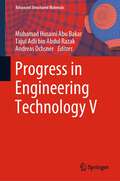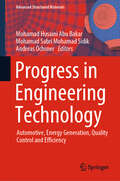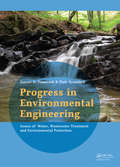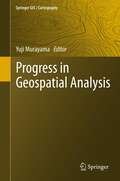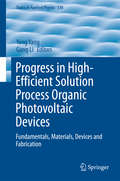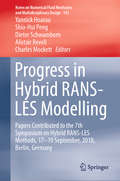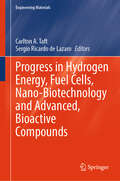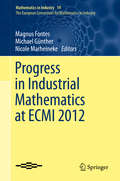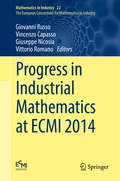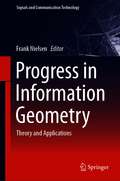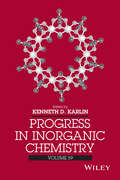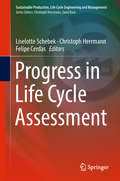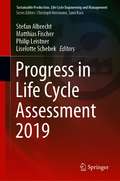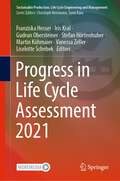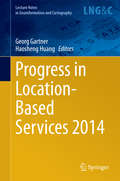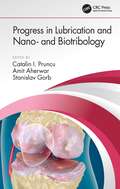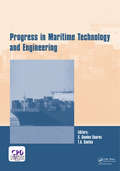- Table View
- List View
Progress in Engineering Technology V (Advanced Structured Materials #183)
by Andreas Öchsner Muhamad Husaini Abu Bakar Tajul Adli bin Abdul RazakThe book contains a selection of peer-reviewed papers from the 2022 conferences, which took place at the Universiti Kuala Lumpur, Malaysian Spanish Institute (UniKL MSI), Kedah, Malaysia. This book contains twenty-two papers written by researchers participating in the conferences. Topics covered in this book include composite materials, thermodynamics, vibration, dynamics of structures, manufacturing processes, computer-aided manufacturing, CFD analysis, design and optimization of devices, and procedures. The topics are commonly encountered in industries and become an interest in the academic world. The learning of engineering technology’s curricular across universities is now an essential topic covered in various higher learning institutions. Therefore, it is hoped that this book serves as an excellent reference for researchers and graduate students working with/on multidisciplinary engineering technology.
Progress in Engineering Technology VI (Advanced Structured Materials #229)
by Tajul Adli Abdul Razak Ahmad Kamal Ismail Andreas ÖchsnerThis book features 31 studies that collectively explore a wide range of innovative engineering solutions and advanced technologies across various fields. Most of the studies focus on designing, analyzing, and optimizing systems that improve efficiency and performance. The papers highlight cutting-edge methodologies and applications, from hydro turbine installations in underground pipelines to using nanofluids for CPU cooling. Key projects include the development of autonomous vehicles for flood detection, innovative composites for automotive applications, and advanced monitoring systems for industrial machinery. Together, these contributions tackle real-world challenges and expand the horizons of engineering practices, emphasizing the significance of interdisciplinary research in delivering impactful solutions for the future.
Progress in Engineering Technology: Automotive, Energy Generation, Quality Control and Efficiency (Advanced Structured Materials #119)
by Andreas Öchsner Muhamad Husaini Abu Bakar Mohamad Sabri Mohamad SidikThis book presents recent developments in the areas of engineering and technology, focusing on experimental, numerical, and theoretical approaches. In the first part, the emphasis is on the emerging area of electromobility and its sub-disciplines, e.g. battery development, improved efficiency due to new designs and materials, and intelligent control approaches. In turn, the book’s second part addresses the broader topic of energy conversion and generation based on classical (petrol engines) and more modern approaches (e.g. turbines). The third and last part addresses quality control and boosting engineering efficiency in a broader sense. Topics covered include e.g. modern contactless screening methods and related image processing.
Progress in Environmental Engineering: Water, Wastewater Treatment and Environmental Protection Issues
by Piotr Koszelnik Janusz A. TomaszekProgress in Environmental Engineering contains theoretical and experimental contributions on water purification, new concepts andmethods of wastewater treatment, and ecological problems in freshwater ecosystems. The issues dealt with in the book include:(i) Causes and control of activated sludge bulking and foaming(ii) e use of new support material
Progress in Food Preservation
by Gopinadhan Paliyath Rajeev Bhat Abd Karim AliasThis volume presents a wide range of new approaches aimed at improving the safety and quality of food products and agricultural commodities. Each chapter provides in-depth information on new and emerging food preservation techniques including those relating to decontamination, drying and dehydration, packaging innovations and the use of botanicals as natural preservatives for fresh animal and plant products. The 28 chapters, contributed by an international team of experienced researchers, are presented in five sections, covering: Novel decontamination techniques Novel preservation techniques Active and atmospheric packaging Food packaging Mathematical modelling of food preservation processes Natural preservatives This title will be of great interest to food scientists and engineers based in food manufacturing and in research establishments. It will also be useful to advanced students of food science and technology.
Progress in Geospatial Analysis
by Yuji MurayamaThis book examines current trends and developments in the methods and applications of geospatial analysis and highlights future development prospects. It provides a comprehensive discussion of remote sensing- and geographical information system (GIS)-based data processing techniques, current practices, theories, models, and applications of geospatial analysis. Data acquisition and processing techniques such as remote sensing image selections, classifications, accuracy assessments, models of GIS data, and spatial modeling processes are the focus of the first part of the book. In the second part, theories and methods related to fuzzy sets, spatial weights and prominence, geographically weighted regression, weight of evidence, Markov-cellular automata, artificial neural network, agent-based simulation, multi-criteria evaluation, analytic hierarchy process, and a GIS network model are included. Part three presents selected best practices in geospatial analysis. The chapters, all by expert authors, are arranged so that readers who are new to the field will gain an overview and important insights. Those readers who are already practitioners will gain from the advanced and updated materials and state-of-the-art developments in geospatial analysis.
Progress in High-Efficient Solution Process Organic Photovoltaic Devices
by Yang Yang Gang LiThis book presents an important technique to process organic photovoltaic devices. The basics, materials aspects and manufacturing of photovoltaic devices with solution processing are explained. Solution processable organic solar cells - polymer or solution processable small molecules - have the potential to significantly reduce the costs for solar electricity and energy payback time due to the low material costs for the cells, low cost and fast fabrication processes (ambient, roll-to-roll), high material utilization etc. In addition, organic photovoltaics (OPV) also provides attractive properties like flexibility, colorful displays and transparency which could open new market opportunities. The material and device innovations lead to improved efficiency by 8% for organic photovoltaic solar cells, compared to 4% in 2005. Both academic and industry research have significant interest in the development of this technology. This book gives an overview of the booming technology, focusing on the solution process for organic solar cells and provides a state-of-the-art report of the latest developments. World class experts cover fundamental, materials, devices and manufacturing technology of OPV technology.
Progress in Hybrid RANS-LES Modelling: Papers Contributed To The 5th Symposium On Hybrid Rans-les Methods, 19-21 March 2014, College Station, A&m University, Texas, Usa (Notes On Numerical Fluid Mechanics And Multidisciplinary Design Ser. #130)
by Shia-Hui Peng Dieter Schwamborn Yannick Hoarau Alistair RevellThis book reports on the latest developments in computational fluid dynamics and turbulence modeling, with a special emphasis on hybrid RANS-LES methods and their industrial applications. It gathers the proceedings of the Sixth Symposium on Hybrid RANS-LES Methods, held on September 26-28 in Strasbourg, France. The different chapters covers a wealth of topics such as flow control, aero-acoustics, aero-elasticity and CFD-based multidisciplinary optimization. Further topics include wall-modelled Large Eddy Simulation (WMLES), embedded LES, Lattice-Bolzman methods, turbulence-resolving applications and comparisons between LES, hybrid RANS-LES and URANS methods. The book addresses academic researchers, graduate students, industrial engineers, as well as industrial R&D managers and consultants dealing with turbulence modelling, simulation and measurement, and with multidisciplinary applications of computational fluid dynamics.
Progress in Hybrid RANS-LES Modelling: Papers Contributed to the 7th Symposium on Hybrid RANS-LES Methods, 17–19 September, 2018, Berlin, Germany (Notes on Numerical Fluid Mechanics and Multidisciplinary Design #143)
by Shia-Hui Peng Dieter Schwamborn Charles Mockett Yannick Hoarau Alistair RevellThis book gathers the proceedings of the Seventh Symposium on Hybrid RANS-LES Methods, which was held on September 17-19 in Berlin, Germany. The different chapters, written by leading experts, reports on the most recent developments in flow physics modelling, and gives a special emphasis to industrially relevant applications of hybrid RANS-LES methods and other turbulence-resolving modelling approaches. The book addresses academic researchers, graduate students, industrial engineers, as well as industrial R&D managers and consultants dealing with turbulence modelling, simulation and measurement, and with multidisciplinary applications of computational fluid dynamics (CFD), such as flow control, aero-acoustics, aero-elasticity and CFD-based multidisciplinary optimization. It discusses in particular advanced hybrid RANS-LES methods. Further topics include wall-modelled Large Eddy Simulation (WMLES) methods, embedded LES, Lattice-Bolzman methods and turbulence-resolving applications and a comparison of the LES methods with both hybrid RANS-LES and URANS methods. Overall, the book provides readers with a snapshot on the state-of-the-art in CFD and turbulence modelling, with a special focus to hybrid RANS-LES methods and their industrial applications.
Progress in Hydrogen Energy, Fuel Cells, Nano-Biotechnology and Advanced, Bioactive Compounds (Engineering Materials)
by Carlton A. Taft Sergio Ricardo de LazaroFrom cutting-edge quantum dots poised to revolutionize energy, health, and environmental sectors to the intricate design and characterization of perovskite-based solar cells, this comprehensive volume delves into the forefront of materials science and technology. Offering both theoretical depth and practical insights, it explores the latest advancements in fuel cells, spintronics, and quantum computing materials. Furthermore, it scrutinizes the mesmerizing realm of magnetism, phonon dynamics, and thermophysical properties through a detailed examination of gamma-Fe4N. Seamlessly integrating theory with experimentation, this book serves as an indispensable resource for researchers, engineers, and enthusiasts navigating the dynamic landscape of modern materials innovation.
Progress in Image Processing, Pattern Recognition and Communication Systems: Proceedings of the Conference (CORES, IP&C, ACS) - June 28-30 2021 (Lecture Notes in Networks and Systems #255)
by Ryszard S. Choraś Jerzy Pejaś Marek Kurzyński Tomasz Hyla Michal Choraś Paweł TrajdosThis book presents a collection of high-quality research papers accepted to multi-conference consisting of International Conference on Image Processing and Communications (IP&C 2021), International Conference on Computer Recognition Systems (CORES 2021), International Conference on Advanced Computer Systems (ACS 2021) held jointly in Bydgoszcz, Poland (virtually), in June 2021. The accepted papers address current computer science and computer systems-related technological challenges and solutions, as well as many practical applications and results. The first part of the book deals with advances in pattern recognition and classifiers, the second part is devoted to image processing and computer vision, while the third part addresses practical applications of computer recognition systems. Machine learning solutions for security and networks are tackled in part four of the book, while the last part collects papers on progress in advanced computer systems. We believe this book will be interesting for researchers and practitioners in many fields of computer science and IT applications.
Progress in Industrial Mathematics at ECMI 2012
by Michael Günther Magnus Fontes Nicole MarheinekeThis book contains the proceedings of the 17th European Conference on Mathematics for Industry, ECMI2012, held in Lund, Sweden, July 2012, at which ECMI celebrated its 25th anniversary. It covers mathematics in a wide range of applications and methods, from circuit and electromagnetic devices, environment, fibers, flow, medicine, robotics and automotive industry, further applications to methods and education. The book includes contributions from leading figures in business, science and academia that promote the application of mathematics to industry and emphasize industrial sectors that offer the most exciting opportunities. The contributions reinforce the role of mathematics as being a catalyst for innovation as well as an overarching resource for industry and business. The book features an accessible presentation of real-world problems in industry and finance, provides insight and tools for engineers and scientists who will help them to solve similar problems and offers modeling and simulation techniques that will provide mathematicians with a source of fresh ideas and inspiration.
Progress in Industrial Mathematics at ECMI 2014
by Vincenzo Capasso Giuseppe Nicosia Giovanni Russo Vittorio RomanoThis book presents a collection of papers emphasizing applications of mathematical models and methods to real-world problems of relevance for industry, life science, environment, finance and so on. The biannual Conference of ECMI (the European Consortium of Mathematics in Industry) held in 2014 focused on various aspects of industrial and applied mathematics. The five main topics addressed at the conference were mathematical models in life science, material science and semiconductors, mathematical methods in the environment, design automation and industrial applications, and computational finance. Several other topics have been treated, such as, among others, optimization and inverse problems, education, numerical methods for stiff pdes, model reduction, imaging processing, multi physics simulation, mathematical models in textile industry. The conference, which brought together applied mathematicians and experts from industry, provided a unique opportunity to exchange ideas, problems and methodologies, bridging the gap between mathematics and industry and contributing to the advancement of science and technology. The conference has included a presentation of EU-Maths-In (European Network of Mathematics for Industry and Innovation), a recent joint initiative of ECMI and EMS. The proceedings from this conference represent a snapshot of the current activity in industrial mathematics in Europe, and are highly relevant to anybody interested in the latest applications of mathematics to industrial problems.
Progress in Information Geometry: Theory and Applications (Signals and Communication Technology)
by Frank NielsenThis book focuses on information-geometric manifolds of structured data and models and related applied mathematics. It features new and fruitful interactions between several branches of science: Advanced Signal/Image/Video Processing, Complex Data Modeling and Analysis, Statistics on Manifolds, Topology/Machine/Deep Learning and Artificial Intelligence. The selection of applications makes the book a substantial information source, not only for academic scientist but it is also highly relevant for industry. The book project was initiated following discussions at the international conference GSI’2019 – Geometric Science of Information that was held at ENAC, Toulouse (France).
Progress in Inorganic Chemistry
by Kenneth D. KarlinPROGRESS in Inorganic ChemistryThe cutting edge of scientific reportingNowhere is creative scientific talent busier than in the world of inorganic chemistry experimentation. Progress in Inorganic Chemistry continues in its tradition of being the most respected avenue for exchanging innovative research. This series provides inorganic chemists and materials scientists with a forum for critical, authoritative evaluations of advances in every area of the discipline. With contributions from internationally renowned chemists, this latest volume offers an in-depth, far-ranging examination of the changing face of the field, providing a tantalizing glimpse of the emerging state of the science."This series is distinguished not only by its scope and breadth, but also by the depth and quality of the reviews." -Journal of the American Chemical Society"[This series] has won a deservedly honored place on the bookshelf of the chemist attempting to keep afloat in the torrent of original papers on inorganic chemistry." -Chemistry in BritainCONTENTS OF VOLUME 57Mechanisms of Water Oxidation Catalyzed by Ruthenium Coordination Complexes (Aurora E. Clark and James K. Hurst)Biomimetic and non-biological dinuclear Mx+-complex catalyzed alcoholysis reactions of phosphoryl transfer reactions (R. Stan Brown)Photoactivated DNA Cleavage and Anticancer Activity of 3d-Metal Complexes (Akhil R. Chakravarty and Mithun Roy)Design and Evolution of Artificial Metalloenzymes: Biomimetic Aspects (Marc Creus and Thomas R.Ward)Functionalization of Fluorinated Aromatics by Nickel-Mediated C-H and C-F Bond Oxidative Addition: Prospects for the Synthesis of Fluorine-Containing Pharmaceuticals (Samuel A. Johnson, Jillian A. Hatnean, Meghan E. Doster)DNA-Based Metal Catalysis (Jens Oelerich and Gerard Roelfes)Metallo-lactamases and their Synthetic Mimics: Structure, Function and Catalytic Mechanism (Muthaiah Umayal, A. Tamilselvi, and Govindasamy Mugesh)A New Class of Nanostructured Inorganic-Organic Hybrid Semiconductors Based on II-VI Binary Compounds (Jing Li and Ruibo Zhang)Oxygen Evolution Reaction Chemistry of Oxide-Based Electrodes (Yogesh Surendranath and Daniel G. Nocera)
Progress in Inorganic Chemistry (Progress in Inorganic Chemistry #115)
by Kenneth D. KarlinThis series provides inorganic chemists and materials scientists with a forum for critical, authoritative evaluations of advances in every area of the discipline. Volume 58 continues to report recent advances with a significant, up-to-date selection of contributions by internationally-recognized researchers. The chapters of this volume are devoted to the following topics: • Tris(dithiolene) Chemistry: A Golden Jubilee • How to find an HNO needle in a (bio)-chemical Haystack • Photoactive Metal Nitrosyl and Carbonyl Complexes Derived from Designed Auxiliary Ligands: An Emerging Class of Photochemotherapeutics • Metal--Metal Bond-Containing Complexes as Catalysts for C--H Functionalization Iron Catalysis in Synthetic Chemistry • Reactive Transition Metal Nitride Complexes Suitable for inorganic chemists and materials scientists in academia, government, and industries including pharmaceutical, fine chemical, biotech, and agricultural.
Progress in Intelligent Decision Science: Proceeding of IDS 2020 (Advances in Intelligent Systems and Computing #1301)
by Tofigh Allahviranloo Soheil Salahshour Nafiz AricaThis book contains the topics of artificial intelligence and deep learning that do have much application in real-life problems. The concept of uncertainty has long been used in applied science, especially decision making and a logical decision must be made in the field of uncertainty or in the real-life environment that is formed and combined with vague concepts and data. The chapters of this book are connected to the new concepts and aspects of decision making with uncertainty. Besides, other chapters are involved with the concept of data mining and decision making under uncertain computations.
Progress in Life Cycle Assessment (Sustainable Production, Life Cycle Engineering and Management)
by Christoph Herrmann Liselotte Schebek Felipe CerdasThe book contains the latest developments in the field of life cycle assessment (LCA) and its application. It contains numerous research articles from leading German research institutes working towards the further development of the methodology. The book provides important insights for professionals working in the field of sustainability assessment, for researchers interested in the current state of the research of the methodology and its application as well as for advanced university students in different science and engineering fields.
Progress in Life Cycle Assessment 2018 (Sustainable Production, Life Cycle Engineering and Management)
by Maximilian Hempel Liselotte Schebek Frank TeutebergThis book comprises recent developments in life cycle assessment (LCA) both with regards to the methodology and its application in various research fields, including mobility, engineering and manufacturing. Containing numerous original research articles from leading German research institutes, the book provides an insightful resource for professionals working in the field of sustainability assessment, for researchers interested in the current state of LCA research as well as for advanced university students in different scientific and engineering fields.
Progress in Life Cycle Assessment 2019 (Sustainable Production, Life Cycle Engineering and Management)
by Liselotte Schebek Matthias Fischer Stefan Albrecht Philip LeistnerThis book covers the latest developments in life cycle assessment LCA both in terms of methodology and its application in various research areas. It includes methodological questions as well as case studies concerning energy and mobility, materials and engineering, sustainable construction and future technologies. With numerous research articles from leading German and Austrian research institutes, the book is a valuable source for professionals working in the field of sustainability assessment, researchers interested in the current state of LCA research, and advanced university students in various scientific and technical fields.Chapter “Life Cycle Assessment of a Hydrogen and Fuel Cell RoPax Ferry Prototype” is available open access under a Creative Commons Attribution 4.0 International License via link.springer.com.
Progress in Life Cycle Assessment 2021 (Sustainable Production, Life Cycle Engineering and Management)
by Liselotte Schebek Franziska Hesser Iris Kral Gudrun Obersteiner Stefan Hörtenhuber Martin Kühmaier Vanessa ZellerThis book covers the latest developments in life cycle assessment (LCA) both in terms of methodology and its application in various research areas. It includes methodological questions as well as case studies of strategies in the context of circular economy and new emerging technologies, design of conceptual frameworks, especially related to social LCA, and the use of novel modeling approaches with a focus on energy supply and land use. With research articles from leading German and Austrian research institutes, the book is a valuable source for professionals working in the field of sustainability assessment, researchers interested in the current state of LCA research, and advanced university students in various scientific and technical fields. 6 chapters are available open access under a Creative Commons Attribution 4.0 International License via link.springer.com.
Progress in Location-Based Services 2014
by Georg Gartner Haosheng HuangThis book presents a general picture of recent research activities related to location-based services. Such activities emerged in the last years especially concerning issues of outdoor/indoor positioning, smart environment, spatial modelling, personalization and context-awareness, cartographic communication, novel user interfaces, crowdsourcing, social media, big data analysis, usability and privacy. This book is comprised of a selection of the best papers presented during the 11th International Symposium on Location Based Services, which was held in Vienna (Austria) between 26th and 28th November 2014.
Progress in Location-Based Services 2016
by Georg Gartner Haosheng HuangThis book offers a selection of the best papers presented at the 13th International Symposium on Location Based Services (LBS 2016), which was held in Vienna (Austria) from November 14 to 16, 2016. It provides an overview of recent research in the field, including the latest advances in outdoor/indoor positioning, smart environment, spatial modeling, personalization and context awareness, cartographic communication, novel user interfaces, crowd sourcing, social media, big data analysis, usability and privacy.
Progress in Lubrication and Nano- and Biotribology
by Catalin I. PruncuTribology is a multidisciplinary science that encompasses mechanical engineering, materials science, surface engineering, lubricants, and additives chemistry with tremendous applications. Progress in Lubrication and Nano- and Biotribology discusses the latest in lubrication engineering and nano- and biotribology. This book: Discusses green tribology and snakeskin tribology Explains biogreases and nanolubricant additives Explores applications in aerospace, additively manufactured parts, and severe environments Written for researchers and advanced students, this book encompasses a wide-ranging view of the latest in nano- and biotribology for a variety of cross-disciplinary applications.
Progress in Maritime Technology and Engineering: Proceedings of the 4th International Conference on Maritime Technology and Engineering (MARTECH 2018), May 7-9, 2018, Lisbon, Portugal
by Carlos Guedes Soares T. A. SantosProgress in Maritime Technology and Engineering collects the papers presented at the 4th International Conference on Maritime Technology and Engineering (MARTECH 2018, Lisbon, Portugal, 7–9 May 2018). This conference has evolved from a series of biannual national conferences in Portugal, and has developed into an international event, reflecting the internationalization of the maritime sector and its activities. MARTECH 2018 is the fourth in this new series of biannual conferences. Progress in Maritime Technology and Engineering contains about 80 contributions from authors from all parts of the world, which were reviewed by an International Scientific Committee. The book is divided into the subject areas below:- Port performance- Maritime transportation and economics- Big data in shipping- Intelligent ship navigation- Ship performance- Computational fluid dynamics- Resistance and propulsion- Ship propulsion- Dynamics and control- Marine pollution and sustainability- Ship design- Ship structures- Structures in composite materials- Shipyard technology- Coating and corrosion- Maintenance- Risk analysis- Offshore and subsea technology- Ship motion- Ships in transit- Wave-structure interaction- Wave and wind energy- Waves Progress in Maritime Technology and Engineering will be of interest to academics and professionals involved in the above mentioned areas.
